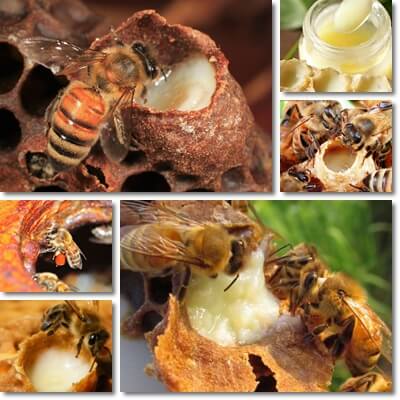Royal jelly is a milky substance secreted from the salivary glands of worker honey bees. In bee colonies, it is used to feed freshly hatched honey bees during their first few days of life and honey bee queens for their entire lifespan. In human nutrition, royal jelly is a dietary supplement proposed to improve health status and possibly certain medical conditions. The therapeutic value of royal jelly includes benefits such as an energizing, anti-fatigue effect, antibacterial, anti-inflammatory and immune-boosting properties, emollient action, improved sleep and concentration, potential beneficial effects on fertility, blood glucose levels and insulin resistance.
What is royal jelly made of? Royal jelly is, for the most part, water. It further contains a great variety of nutrients, notably macronutrients such as carbohydrates or sugars, proteins, amino acids, including essential amino acids, fatty acids with antioxidant activity and enzymes. The bee product also contains essential vitamins and dietary minerals, notably vitamins A, C and E, B vitamins, potassium, phosphorus, sodium and others. For an insect the size of a honey bee, it is an excellent source of nutrition. However, for an average person, it is a source of additional nutrients required for excellent health.

What does royal jelly look like? The color of royal jelly may vary from whitish to a milky yellow. The lighter the color, the fresher the product. As for texture, royal jelly has a soft, creamy, but thick consistency. What does royal jelly taste like? The bee product has an unpleasant, but unique taste. Overall, it tastes somewhat spoilt, with acidic, faintly sweet, strong bitter-medicinal, even sour flavors. The stronger and more unpleasant the taste, the fresher the jelly. Storage conditions, exposure to air, light and different temperatures may alter the color, taste and properties of royal jelly.
How to use royal jelly
Different amounts of royal jelly may be required for various purposes, so specifics such as how much royal jelly you should eat, how to best use royal jelly or how to know when it’s good or bad for you are best established by a doctor. Because there can be risks associated with eating royal jelly or taking various supplements, it is important to always ask the advice of a doctor. Very often, royal jelly is eaten alone, before a meal. Some recommend keeping it under the tongue and letting it slowly mix with saliva to produce the most potent effects.
Because of its strong, unpleasant taste, royal jelly is known to be mixed with other bee products such as bee pollen, different honey varieties or propolis. However, if combined with other bee products, remember to check the label to see the exact percentage of royal jelly listed. The most benefits are obtained from consuming the fresh product in the morning or afternoon and it should be stored in air-tight, opaque jars or containers, in cool, dark places. If the taste is too much, there are always tablets, soft gel capsules or powder royal jelly supplements.

Health benefits
What does royal jelly do for our health? If there are no restrictions for its consumption, the bee product can be a great addition to our diet, supplying important nutrients, antioxidants and other elements with beneficial health effects. Here are 11 surprising benefits of royal jelly:
1) Effect on insulin metabolism and blood sugar lowering properties. Research suggests royal jelly can encourage insulin secretion by improving fasting plasma glucose levels and insulinogenic index. This could contribute to improved insulin resistance and better overall health. However, there are studies that have found no effect of royal jelly on insulin resistance or sensitivity, but observed a decrease in blood sugar levels, indicating a beneficial action and potential for use in lowering diabetes risks.
2) Can improve fertility in men. Studies show royal jelly is good for male fertility because it increases testosterone levels, reducing infertility rates. Its beneficial effects are partly a result of its content of zinc, B vitamins and vitamin C, all nutrients that boost fertility.
3) Potentially good for anemia. While its effects are not considered statistically important, by improving hormone levels and male fertility, royal jelly indirectly contributes to a process called erythropoiesis, supporting the production of red blood cells or increasing the duration of their life cycle. This has direct implications on anemia because it contributes to higher hemoglobin levels, hemoglobin being a protein in red blood cells that transports oxygen to feed muscles and generate energy.
Participants to one study were given 3,000 mg of royal jelly a day for 6 months, after which the results of the supplementation were measured (Effect of royal jelly ingestion for six months on healthy volunteers). However, it is important to understand there are multiple causes that lead to the onset of anemia and managing and treating the condition might require more than royal jelly supplements.
4) Good for anxiety and depression. Royal jelly has been found to contain a special unsaturated (healthy) fatty acid that exhibits a protective action against anxiety and depression.
5) Promotes endocrine health in older women. It has been shown that eating royal jelly can encourage a steadier production of hormones such as estrogen (known to decrease with age), promoting hormonal balance and endocrine health in older women. Some women report it also helps with adult acne, cramps, mood swings, lethargy and foggy thinking.
6) Good for female fertility. Research suggests its beneficial effect may also aid fertility in younger women by supporting enzymatic reactions that result in the production of estrogen. The effects of royal jelly on estrogen production are selective, meaning its action is not global, but merely directed at supporting uterus and ovary health. These findings indicate royal jelly may be a great aid for succesful conception, improving fertility and pregnancy chances. However, the bee product is reported to be good for women with low estrogen levels, not for those with high estrogen.
7) Exhibits antitumour activity. Despite its estrogenic action, royal jelly is a source of antioxidants and fatty acids with antioxidant and antitumour activity. Antioxidants protect cells against oxidative stress, preventing excessive damage that could favor uncontrollable growth and tumour formation. Moreover, eating royal jelly is said to boost immunity, improving our body’s natural responses against infection and disease, cancer included.
8) Natural antibacterial and anti-inflammatory. Royal jelly has been found to exert an anti-inflammatory action, reducing inflammation levels in the body thanks to its direct action on a type of small protein called cytokine. These proteins, cytokines, play important roles in inflammatory and immune system responses. Moreover, royal jelly exerts an antibacterial and emollient action and stimulates collagen production, contributing to wound healing and skin care.
9) Source of nutrients. The bee product provides small amounts of several essential vitamins and minerals, notably vitamins A, C and E, B vitamins and zinc, proteins, amino acids, fatty acids, carbohydrates, enzymes, but also other elements with nutritional value. But while an insect as small as a queen bee can happily live off royal jelly, for us it cannot substitute a healthy, balanced and varied diet and remains a functional food, a dietary supplement which can contribute to better health.
10) Good for low energy levels and fatigue. Consumers report the bee product helps raise energy levels and combat fatigue, restore vitality and support physical activity. It is also thought to improve sleep quality and relieve insomnia as well as improve disposition and mood swings.
11) Good for the brain. Eating royal jelly is said to be good for brain fog, helping restore focus and attention. Moreover, it is believed to relieve apathy and restore good mood, contributing to mental health. Emerging research suggests it can improve spatial memory, indicating a potential use for the treatment and management of Alzheimer’s disease.
Risks and side effects
1) Allergic reaction and anaphylactic shock. Because it is a bee product, royal jelly carries a risk of allergic reaction and anaphylactic shock (severe, life threatening condition). While anyone can be allergic to it, those with existing allergies, especially pollen, honey and bee allergies are the most likely to be allergic to royal jelly.
2) Bacteria or other types of contamination. Just like different honey varieties or bee pollen, royal jelly too may be contaminated with various microorganisms and pose certain health risks because of this. This is why it is important to get your royal jelly from a trusted producer who can guarantee the product’s good quality and lack of contaminants.
3) Potentially unsafe for pregnant women, infants and young children. More research is needed to know whether or not royal jelly is safe for certain categories of people. At this point, risks and side effects are unknown for pregnant women and small children.
4) Varying therapeutic action. Royal jelly does not have the same therapeutic action for everyone. There are reports of it being ineffective for some people or certain conditions, whilst effective for others. There is no guarantee it is equally good for everyone.
Conclusion
Research on the properties and benefits of royal jelly presents it as a source of nutrients with a wonderful therapeutic potential, but does not consider recommended amounts are sufficient to produce visible health effects. Nevertheless, eating royal jelly is reported to help with a variety of health issues. The bee product is shown to help with infertility, insulin resistance, mental fog, poor concentration, insomnia, mood swings, anxiety, tiredness, acne and skin care in general and exert substantial anti-inflammatory, antibacterial, antioxidant, antitumour and emollient properties.
